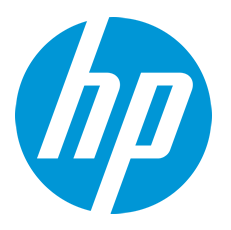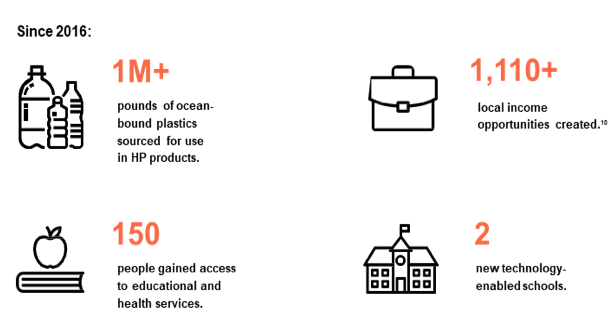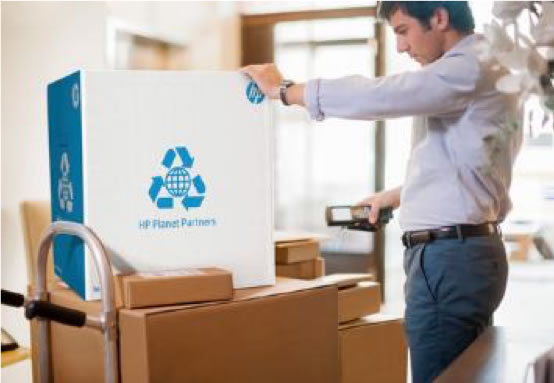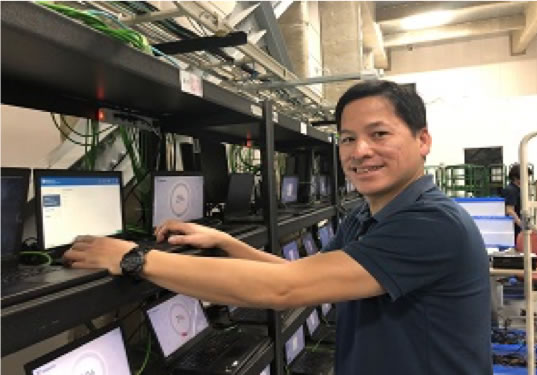 HP has a legacy of leading the way when it comes to sustainability. In 1987 they became the first PC manufacturer to offer a hardware recycling program, and just five years later, launched their global HP Planet Partners program.
HP has a legacy of leading the way when it comes to sustainability. In 1987 they became the first PC manufacturer to offer a hardware recycling program, and just five years later, launched their global HP Planet Partners program.
With the growing need for corporations to reduce their impact on the planet, HP continues to set the bar for other PC and print manufacturers, unveiling ambitious targets for the future of their sustainability endeavours.
HP is determined to reduce the amount of ocean-bound plastic globally by incorporating it into new products, a win for both consumers and the environment. In 2019, they proudly announced the first use of ocean-bound plastic in PC products.1
The goal is to keep plastic from reaching the ocean in the first place. HP is taking plastic that would otherwise end up in the ocean and upcycling it to create new HP hardware and print supplies through the HP Planet Partners recycling program.

So far, they’ve used more than 2.4 million pounds of ocean-bound plastic in HP products – equivalent to 85 million plastic bottles – and announced a new goal to eliminate 75% of single-use plastic packaging by 2025 compared to 2018. They also launched the world’s first notebook, display, mobile workstation and enterprise Chromebook – utilising ocean-bound plastic.
HP is also working to protect and restore critical forests globally. In a huge step, has eliminated 99% of deforestation for its paper-based product packaging.2 Now, HP is committed to counteracting deforestation for non-HP paper used in its products and print services by 2030.3
The global technology company’s ultimate goal is to achieve net zero emissions across its value chain by 2040. As part of that journey, HP is innovating to reduce greenhouse gas emissions from its products, and already leads the industry with the highest number of Gold EPEAT products!4
With its legacy and vision, HP is poised to lead the technology industry in achieving rigorous, comprehensive goals that not only address its impact on the planet, but on its people and communities.

Tackling Plastics in the Future

- 25,000 tonnes of recycled plastic used in HP hardware and supplies during 2019
- Goal: 30% postconsumer plastic used in PCs/printers (2025) 5
- Goal: 75% elimination of single-use plastic packaging 6
- 642,300 tonnes of hardware and supplies, recycled, through 2020
- Goal: 1.2 million tonnes of products recycled by 2025
Recycled Product Materials

Increasing the use of recycled content in HP products
- HP E273d Monitor - World’s first display manufactured with ocean-bound plastic.
- HP Renew Sleeve - HP’s first sleeve made from recycled plastic
- HP U28 4K HDR Monitor - First consumer monitor made from 5% ocean-bound plastic
“World’s First” innovations from HP

Using ocean-bound plastic material
- HP Ink Cartridges
- HP Elite Dragonfly
- HP ZBook Create and ZBook Studio
- HP Elite c1030 Chromebook
What Else are HP Doing?
- Phasing out hard-to-recycle expanded plastic foam cushions in favour of readily recyclable, 100% recycled content moulded pulp cushions for HP commercial and consumer desktop towers, for HP commercial and consumer notebooks
- Eliminated the plastic cushions of over 3.2 M desktops, thereby eliminating over 831 metric tonnes of plastic foam in FY19.
- Eliminated the plastic cushions of over 3.4 M notebooks, approximately 214 metric tonnes of plastic foam in FY19.
- 4.6 billion new HP ink or toner cartridges with recycled content.
Download the Infographic
Discover HP's Sustainable Impact Progress 2020 on our downloadable Infographic.
Download Infographic- Ocean-bound plastics are any plastic products found within 30 miles of a waterway or coastal area that have not been collected and are not likely to be, according to NextWave Plastics, an HP partner. Much of that waste finds its way into the water, putting sea life and their habitat at risk.
- As of December 2020, 99% of HP brand paper and paper-based product packaging was derived from certified or recycled sources. Packaging is the box that comes with the product and all paper-based materials inside the box. Packaging for commercial, industrial, and 3D products, scanners, personal systems accessories, and spare parts are not included.
- Fiber by weight will be 1) certified to rigorous third-party standards, 2) recycled or 3) balanced by forest restoration, protection, and other initiatives through HP’s Forest Positive Framework. Paper does not include fiber-based substrates for HP industrial presses not listed in HP Media Solutions Locator catalogues.
- The Electronic Product Environmental Assessment Tool (EPEAT) is a method for purchasers to evaluate the effect a product has on the environment.
- Recycled content plastic (RCP) as a percentage of total plastic used in all HP personal systems, printer hardware, and print cartridges shipped during the reporting year. Total volume excludes brand-licensed products and after-market hardware accessories. Total RCP includes postconsumer recycled plastic, closed-loop plastic, and ocean-bound plastic used in HP products. Personal systems plastic is defined by EPEAT® eco-label criteria. Subject to relevant restrictions on the use and distribution of materials destined for recycling and/or recycled feedstocks.
- Calculated as the percentage of primary plastic packaging (by weight) reduced per unit shipped. Excludes secondary and tertiary packaging components. Includes HP personal systems and printer hardware packaging. Does not include packaging for the following: Graphics Solutions Business (GSB) hardware other than PageWide XL and DesignJet printers; 3D printing hardware; print supplies; refurbished products; and accessories such as third-party options, drop in box, and aftermarket options.
Contact the Team
Don't have an Intouch login but want to know more? We can send you any additional info you require without any obligation. Let us know how best to reach you here:
Read more of our latest Modern Workplace stories
